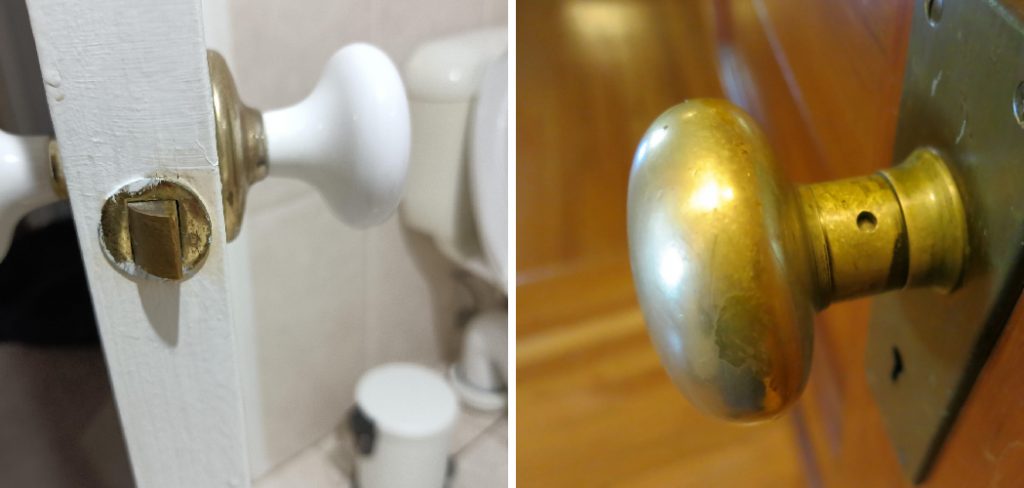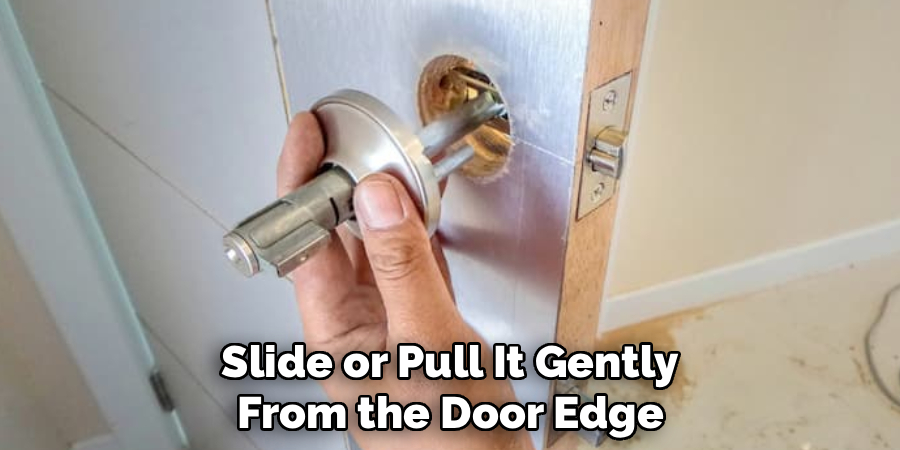Dealing with a locked door knob that has no visible screws can be incredibly frustrating, especially when you need access to a room or want to replace the hardware. Many modern door knobs are designed this way for aesthetic reasons, hiding the screws for a cleaner look.

But don’t worry—removing a locked doorknob without screws is possible with the right approach and some patience. This guide on how to remove a locked door knob with no screws will walk you through each step, ensuring you understand the process and have what you need for a successful job. Let’s get started so you can regain access or update your door hardware with confidence.
Why Would You Need to Remove a Locked Door Knob?
There are several reasons why you might need to remove a locked door knob without screws. Perhaps you’ve lost the keys or the lock is damaged and needs replacing. Maybe you’re updating your interior design and want a different style of door knob. Whatever the reason, knowing how to remove a locked door knob with no screws can save you time and frustration in these situations.
It’s also important to note that not all door knobs are created equal. Some may have visible screws, while others may require a different removal process. It’s always best to consult the manufacturer’s instructions or seek professional help if you’re unsure about how to remove a specific type of locked door knob.
Tools and Materials You’ll Need
- Flathead Screwdriver
- Phillips Head Screwdriver
- Paperclip or Pin
- Small Flashlight
- Allen Wrench Set
- Pliers
- Hammer (Optional)
- Lubricant Spray (Optional, for Stubborn Parts)
- Tape (to Secure Small Screws or Cover Surfaces)
- Replacement Door Knob (if Needed)
8 Step-by-step Guidelines on How to Remove a Locked Door Knob With No Screws
Step 1: Assess the Door Knob Design
Before jumping into any work, take a close look at your door knob. Determine whether it is a knob or a lever, and see if there are any visible seams, tiny holes, or slots that provide access to the mechanism.

Examine the faceplate and shaft areas. Many screwless designs have hidden release mechanisms or are held together by friction. Observing these details will inform the ideal approach to removal.
Step 2: Locate the Detent or Release Hole
Most screwless door knobs use a hidden detent or pinhole for release. With your flashlight, look along the shaft or neck of the knob for a small hole or slot.
Once found, you’ll use a small tool—like a paperclip or pin—to engage the detent. This is often the key to loosening the door knob. If you don’t find a hole, recheck along the entire knob, as some are very discreetly placed.
Step 3: Depress the Detent to Loosen the Knob
Straighten your paperclip or use a similar tool and insert it firmly into the hole. Apply steady pressure until you feel the detent give way, which may require a bit of gentle wiggling.
As you maintain pressure on the detent, slowly try to pull or twist the knob. It should begin to move or slide off. Repeat the process if it feels stuck, ensuring you’re aligned with the release point correctly.
Step 4: Remove the Exterior Knob
Once the detent is depressed and the knob loosens, carefully slide or pull it off the spindle. Move slowly to avoid damaging any internal parts or scratching the finish.
Place the removed knob on a safe surface. This will expose the internal mechanism and make the rest of the process much easier. If the knob gets stuck, try gently rocking it back and forth while maintaining detent pressure.

Step 5: Remove the Interior Knob or Plate
With the exterior knob off, inspect the opposite side. There might be another detent or a faceplate with hidden catch points. Repeat the insertion and pressing technique if needed.
Once released, pull off the interior knob or, if required, unsnap or unscrew the faceplate to reveal the mounting hardware within. This step is crucial for reaching the actual locking mechanism and latch.
Step 6: Access and Remove the Mounting Plate
After taking off both knobs, you’ll notice a mounting plate securing the latch assembly. Look for slots or notches allowing the plate to be popped or pried off with a small screwdriver.
Carefully work around the plate to release it. Be patient—forcing it may damage the door or hardware. Removing this plate will let you fully access the interior parts holding the knob in place.
Step 7: Remove the Latch Mechanism
With the mounting plate out, you can now see and manipulate the latch assembly. Slide or pull it gently from the door edge, watching for additional catches or tabs that need to be pressed.
If it resists, apply a small amount of lubricant spray, then try again. Removing the latch mechanism is the final step to freeing up the door and completing the hardware removal process.
Step 8: Install the Replacement or Reassemble
Before installing a new knob or putting the old one back, take a moment to clean up any dust or debris. Align the replacement latch mechanism, then secure it by reversing the previous steps.
Attach the new or original knobs, ensuring all detents or plates snap firmly into place. Test the knob’s function several times to guarantee smooth operation and a proper fit.
Following these steps on how to remove a locked door knob with no screws can save you time and money.

Additional Tips
Always take a photo at each step of disassembly to make reassembly easier. Keep small parts organized—use tape or a container for screws and pins. If your door or knob seems especially old or stiff, a gentle application of lubricant can ease the process.
Never force a component, as this could damage the interior locking mechanism or mar the door’s surface. If you’re unsure at any stage, it’s better to stop and reassess than risk further complications.
Do You Need To Use Professionals?
While most people can handle removing a locked door knob without screws, there are situations where calling a professional makes sense. If the lock is severely jammed or if you encounter nonstandard parts or heavy security features, a locksmith can help you avoid unnecessary damage.
They also have specialized tools that can speed up the process. Additionally, hiring a professional ensures you don’t void warranties on expensive or smart locks. If in doubt, opting for expert help is usually a small price for peace of mind.
How Much Will It Cost?
DIY removal will typically only cost a few dollars if you already own basic tools. Replacement knobs range from $10 to $50, depending on quality and features. Professional locksmith services can cost between $75 and $200, depending on your location and lock complexity.
It may be worth comparing quotes, especially for high-end or commercial hardware. Remember that improper attempts could lead to higher costs if repairs are needed, so weigh the risks before starting. Investing in quality hardware and correct installation now can also save money in the long run.
Frequently Asked Questions
Q1: What If I Can’t Find the Detent or Release Hole?
A1: Sometimes, the detent hole is hidden or covered by decorative components. Carefully inspect all sides; feel with your fingers if necessary. If you’re still unable to locate it, look up the knob’s brand for specific guides. Patience and careful observation are key—avoid forcing parts, as hidden detents are easily damaged.

Q2: Can I Use Household Items as Tools?
A2: Yes, common items like paperclips, bobby pins, or small screwdrivers can often do the trick. The important thing is to use items that are small, sturdy, and won’t break off inside the mechanism. If your tools aren’t working, invest in a proper set for consistent results.
Q3: Is It Safe to Remove the Knob Myself?
A3: For most standard residential knobs, removal is safe if you follow the right steps and exercise patience. However, always be wary of antique, custom, or high-security locksets. These can be more delicate or complex, and improper handling can result in more expensive repairs.
Q4: How Do I Avoid Damaging My Door or Knob?
A4: Always use minimal force and the correct tool for each step. Cover sensitive surfaces with masking tape to prevent scratches. Take your time with each release mechanism, and avoid prying aggressively. If something isn’t responding, retrace your steps before attempting further action.
Conclusion
Removing a locked door knob with no visible screws can seem intimidating, but with careful preparation and a patient, step-by-step approach, it’s within reach for most DIYers. Having the right tools on hand and understanding the structure of your door knob are crucial. Don’t hesitate to seek help for complex situations or unfamiliar hardware.
By following this guide on how to remove a locked door knob with no screws, you can safely and efficiently update your doors, improving both the function and appearance of your living or work space.
About
Safety Fic is a distinguished figure in the world of Diy design, with a decade of expertise creating innovative and sustainable Diy solutions. His professional focus lies in merging traditional craftsmanship with modern manufacturing techniques, fostering designs that are both practical and environmentally conscious. As the author of diy, Safety Fic delves into the art and science of Safety Fic-making, inspiring artisans and industry professionals alike.
Education RMIT University
(Melbourne, Australia) Associate Degree in Design (Safety Fic) Focus on sustainable design, industry-driven projects, and practical craftsmanship. Gained hands-on experience with traditional and digital manufacturing tools, such as CAD and CNC software.
Nottingham Trent University
(United Kingdom) Bachelor’s in diyfastly.com and Product Design (Honors) Specialized in product design with a focus on blending creativity with production techniques. Participated in industry projects, working with companies like John Lewis and Vitsoe to gain real-world insights.
Publications and Impact
In diy, Safety Fic his insights on indoor design processes, materials, and strategies for efficient production. His writing bridges the gap between artisan knowledge and modern industry needs, making it a must-read for both budding designers and seasoned professionals.
